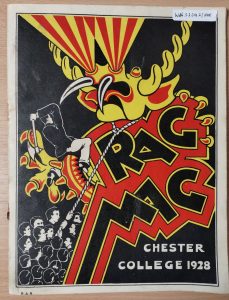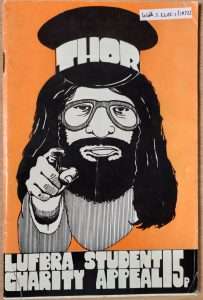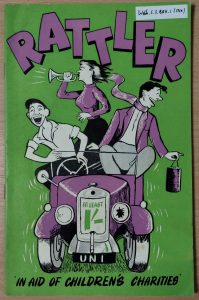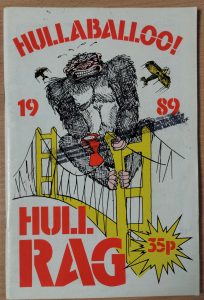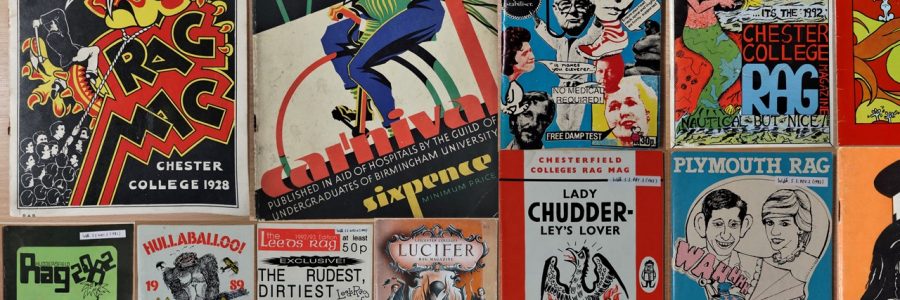
Eighty years of bad jokes: the UL’s rag mag collection
The practice of holding “rag weeks” or “rag days” in Universities to raise money for good causes seems to have started in the 1920s. In Cambridge at least, early rag days were linked to the newly-instituted “Poppy Day” to raise money for veterans of the recent world war, and this link endured until 1966. Elsewhere the effort might be directed at local hospitals or medical or children’s charities. The concept of the student “rag”, meaning a more-or-less rowdy or destructive stunt or happening, goes back well into the nineteenth century, but it was not until the 1920s that these energies were directed into raising money for good causes. The rag magazine soon followed, with most of the “red brick” universities founded in the late nineteenth or early twentieth century producing one issue annually by 1930. Titles included The Rag Rag at Manchester, The Tyke at Leeds, The Rattler at Reading and Pantosfinx at Liverpool. Outside England, Aberystwyth had Keezlewacca, Edinburgh Euragonnah and Belfast Pro Tanto Quid (later PTQ), among others. Early issues tend to be in quarto format, with a consistent cover design for each title in the art-deco style of the day. The content blends cartoons (often reprinted from national publications) and jokes with more long-form humorous pieces in the manner of Punch. There were usually short prefaces by the head of the university, chancellor, rector or principal, and the mayor of the city, commending the efforts of the students and exhorting the townsfolk to dig deep.
By the 1960s a rag mag was an essential production for any university student union. Most of the then-new Universities started one, though few of these publications established a stable identity, with titles and mastheads frequently changing. The earliest example from Cambridge in the collections dates from 1961, and the first from Oxford as late as 1973. Even a few schools, colleges and youth clubs got in on the act, and a selection of their efforts, often laboriously produced in-house with stencils on manual duplicators, can be found in our collection. University student unions could afford more professional production standards. The firm of McMillan Graham of Hazel Grove, Stockport handled printing and publishing for many rag committees from the 1960s, and unsurprisingly the rag mags produced with its help have a strong family resemblance. The format now is generally small octavo, with cover designs changing annually; the longer pieces disappear, and the content largely consists of jokes and cartoons.
The social changes of the late 1960s made themselves felt in both the outward design and content of the magazines. Cover designs become more anarchic, showing the influence of comic books, pop art or graffiti, and the jokes become more unbridled. Gradually, the good-humoured prefaces by chancellors and mayors stop appearing. In 1971 the principal of the University College of North Wales, mountaineer and surgeon Sir Charles Evans, refused to write the customary introduction to Pandamonium because “the standard of the rag magazine over the last few years has, in spite of repeated warnings … been so deplorable”. (The editors printed his refusal instead.) That much of the humour is sexual or scatological is perhaps to be expected, but even the most committed free-speech advocate might balk at defending some of the other material printed in the 1970s and 1980s, when disparaging jokes aimed at every conceivable minority group are a depressingly common feature.
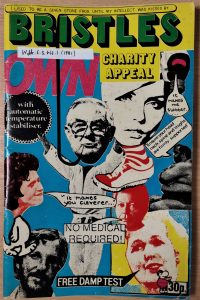
Bristles, Bristol University’s rag mag from 1981, with a collage-style cover depicting contemporary figures.
Racial stereotyping and sexism can of course be found in rag mags before the 1970s as they can in more mainstream humour publications of the period, and conflicts with authority were not unknown even then. The 1950 issue of the Sheffield-based Twikker was banned altogether, supposedly after offending the Mayor; the edition was destroyed (no copy survives today) and its editor sent down from the University. A substitute publication was produced by the local branch of the Infantile Paralysis Fellowship; its depiction of a blackface minstrel on the cover was presumably considered perfectly acceptable.
There is some evidence of pushback against later publications, not so much from the authorities as from fellow students. One issue appears with a sticker on the cover from the students’ union disclaiming all responsibility for the publication. As late as 1987 the Sheffield union attempted (again) to ban Twikker; it was re-instated after a mass general meeting. Some editors gleefully embraced the notoriety, others claimed to have eliminated gratuitously offensive material.
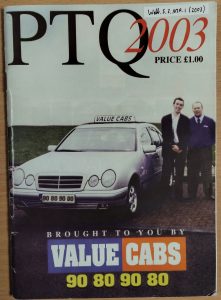
The decline of the rag mag: by 2003, Belfast’s PTQ was advertising the services of a local cab company on its cover
The age of the rag mag came to an end around the turn of the century. Titles appeared increasingly sporadically, and issues became thinner. Though it is tempting to ascribe this to social changes and different standards in what constitutes acceptable humour among the young, the truth appears to be that the economics of magazine production made the rag mag increasingly unviable as a means of raising money. Perhaps the last to appear was Belfast’s PTQ in 2013, and the editor of its final number recently wrote in a Reddit post:
The truth is that it got increasingly hard to shift copies of it. Its niche had long since been overfilled by the internet and the amount of work it took and money it cost to print vs the amount it raised in advertising sales made it unsustainable for the charities we raised for.
 Thanks to the generosity of Friend of the Library Cliff Webb, who has described his collection of school magazines here, the University Library now has a representative collection of rag mags from all over the United Kingdom. Few will now want to read them for entertainment and their inclusion in the collections of the Rare Books Room should not be taken as endorsement of their contents. Nonetheless they are an interesting social document in the history of education and charitable giving, and shine a light into what some students have found funny over eight decades.
Thanks to the generosity of Friend of the Library Cliff Webb, who has described his collection of school magazines here, the University Library now has a representative collection of rag mags from all over the United Kingdom. Few will now want to read them for entertainment and their inclusion in the collections of the Rare Books Room should not be taken as endorsement of their contents. Nonetheless they are an interesting social document in the history of education and charitable giving, and shine a light into what some students have found funny over eight decades.

